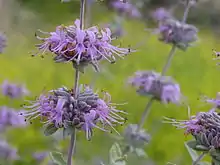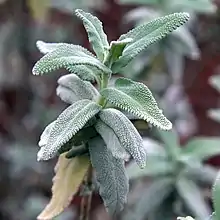Salvia leucophylla
Salvia leucophylla, the San Luis purple sage,[1] purple sage, or gray sage, is an aromatic sage native to the southern coastal mountain ranges of California and Baja California.[2]
| Salvia leucophylla | |
|---|---|
 | |
| Scientific classification | |
| Kingdom: | Plantae |
| Clade: | Tracheophytes |
| Clade: | Angiosperms |
| Clade: | Eudicots |
| Clade: | Asterids |
| Order: | Lamiales |
| Family: | Lamiaceae |
| Genus: | Salvia |
| Species: | S. leucophylla |
| Binomial name | |
| Salvia leucophylla | |

Taxonomy
The plant's specific epithet, leucophylla, describes the light grayish leaves. The type specimen was collected near Santa Barbara, California by Scottish botanist David Douglas and named by Edward Lee Greene in 1892. The common names refer to the pale purple flowers (Purple sage) or to the grayish leaves (Gray sage).[2]
Description
Salvia leucophylla is an evergreen shrub that grows up to 1 to 1.5 m (3.3 to 4.9 ft) tall and wide. Leaves are a light green in the spring, turning grayish-white as they mature, with graceful branches that arch to the ground, sometimes rooting when they touch the ground. Flowers grow in tight whorls on 15 to 20 cm (5.9 to 7.9 in) long inflorescences, with a pinkish-purple flowering stem. The 2.5 cm (0.98 in) flowers are pinkish-purple, held in a purple-tinged gray calyx.[2]
Habitat
The plant is typically found on dry hillsides and in gravelly soils.[2]
Cultivation
Salvia leucophylla is widely used in California and xeriscape gardening, preferring full sun and good drainage. There are many cultivars, natural hybrids, and wild hybrids with other Salvia species, making clear naming very confusing.
Some cultivars include:
- Salvia leucophylla 'Pt. Sal'
- Salvia leucophylla 'Figueroa'
- Salvia leucophylla 'Bee's Bliss'[2]
Salvia leucophylla is known to have allelopathic qualities. It is thought that monoterpenoids released from the plant may be responsible for inhibiting the growth of neighboring seedlings.[3][4]
References
- "Salvia leucophylla". Natural Resources Conservation Service PLANTS Database. USDA. Retrieved 28 October 2015.
- Clebsch, Betsy; Barner, Carol D. (2003). The New Book of Salvias. Timber Press. pp. 174–176. ISBN 978-0-88192-560-9.
- McClure, Susan (1994). Companion Planting. Rodale Press. ISBN 0-87596-616-0.
- Nishida, Nami; Tamotsu, Satoshi; Nagata, Noriko; Saito, Chieko; Sakai, Atsushi (2005-05-01). "Allelopathic Effects of Volatile Monoterpenoids Produced by Salvia leucophylla: Inhibition of Cell Proliferation and DNA Synthesis in the Root Apical Meristem of Brassica campestris Seedlings". Journal of Chemical Ecology. 31 (5): 1187–1203. doi:10.1007/s10886-005-4256-y. ISSN 1573-1561. Retrieved 2020-11-29.
External links
| Wikimedia Commons has media related to Salvia leucophylla. |